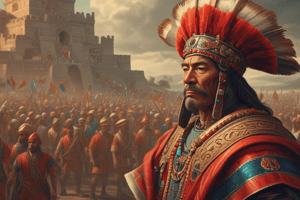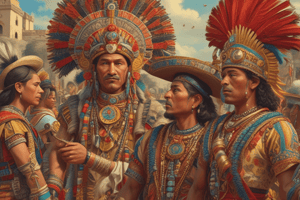Podcast
Questions and Answers
Match each event with its primary cause or trigger during the Spanish conquest of Tenochtitlan:
Match each event with its primary cause or trigger during the Spanish conquest of Tenochtitlan:
Moctezuma's Death = Public stoning by his own people after attempting to appease them. La Noche Triste = The Spaniards' attempt to secretly flee Tenochtitlan on a rainy night, which was discovered by the Mexica. Smallpox Epidemic = Introduction of the disease by a Spanish soldier, devastating the Mexica population. Siege of Tenochtitlan = Cortés' strategic plan to isolate and starve the city, supported by allied forces and naval power.
Match each Spanish Conquistador to their role in the Siege of Tenochtitlan:
Match each Spanish Conquistador to their role in the Siege of Tenochtitlan:
Cortés = Overall commander, directed the strategy and deployment of forces. Pedro de Alvarado = Led one of the three land divisions surrounding Tenochtitlan. Gonzalo de Sandoval = Commanded another land division during the siege. Cristóbal de Olid = Oversaw the remaining land division.
Match each consequence to the event that directly caused it during the Spanish conquest:
Match each consequence to the event that directly caused it during the Spanish conquest:
Widespread famine in Tenochtitlan = Death of farmers due to smallpox. Disarray among the Tlaxcala = Cuitláhuac's attempts to form an alliance with them. Loss of soldiers and equipment = The breaking of the portable bridge during La Noche Triste. Devastation of the Triple Alliance = The death of two kings and decimation of the nobility shortly after the Spanish arrival.
Match the leader to the correct description:
Match the leader to the correct description:
Match the location to its significance during the Spanish Conquest:
Match the location to its significance during the Spanish Conquest:
Match weapon or military technology with its impact during the Siege of Tenochtitlan:
Match weapon or military technology with its impact during the Siege of Tenochtitlan:
Match the effect to the correct event during the Spanish Conquest:
Match the effect to the correct event during the Spanish Conquest:
Match the strategy to the correct description:
Match the strategy to the correct description:
Match the Spanish captains with the causeways they initially assaulted during the siege of Tenochtitlan:
Match the Spanish captains with the causeways they initially assaulted during the siege of Tenochtitlan:
Match the events with the dates they occurred during the siege of Tenochtitlan:
Match the events with the dates they occurred during the siege of Tenochtitlan:
Match the strategies employed by each side during the siege with their objectives:
Match the strategies employed by each side during the siege with their objectives:
Match the outcomes with the events that led to them during the siege:
Match the outcomes with the events that led to them during the siege:
Match the consequences with the conditions in Tenochtitlan during the final stages of the siege:
Match the consequences with the conditions in Tenochtitlan during the final stages of the siege:
Match the individuals involved in the siege with their roles or actions:
Match the individuals involved in the siege with their roles or actions:
Match the military units with their primary roles during the siege:
Match the military units with their primary roles during the siege:
Match the resources with their importance during the siege:
Match the resources with their importance during the siege:
Match the locations with their significance during the siege:
Match the locations with their significance during the siege:
Match the post-siege outcomes with their corresponding descriptions:
Match the post-siege outcomes with their corresponding descriptions:
Match the specific attack outcomes to the related tactical implementations by the attacking side:
Match the specific attack outcomes to the related tactical implementations by the attacking side:
Match the specific defensive advantages to the geographical features that provided them:
Match the specific defensive advantages to the geographical features that provided them:
Match the psychological impacts with the events that caused them during the siege:
Match the psychological impacts with the events that caused them during the siege:
Match the leadership actions with their direct strategic consequences during the siege:
Match the leadership actions with their direct strategic consequences during the siege:
Match the technological or logistical impacts with their specific effects on the siege warfare:
Match the technological or logistical impacts with their specific effects on the siege warfare:
Flashcards
Moctezuma
Moctezuma
Aztec emperor taken hostage by the Spanish; later killed amidst rising tensions.
La Noche Triste
La Noche Triste
Event on July 1, 1520, where Cortés' forces suffered heavy losses while fleeing Tenochtitlan.
Strategic retreat
Strategic retreat
Strategic retreat where Spanish Conquistadors and their allies retreated due to the overwhelming Aztec forces.
Smallpox in Tenochtitlan
Smallpox in Tenochtitlan
Signup and view all the flashcards
Cuitláhuac
Cuitláhuac
Signup and view all the flashcards
Cuauhtémoc
Cuauhtémoc
Signup and view all the flashcards
Siege of Tenochtitlan
Siege of Tenochtitlan
Signup and view all the flashcards
Tlaxcalan forces
Tlaxcalan forces
Signup and view all the flashcards
Land Division Composition
Land Division Composition
Signup and view all the flashcards
Causeway Assignments
Causeway Assignments
Signup and view all the flashcards
Alvarado's Action at Chapultepec
Alvarado's Action at Chapultepec
Signup and view all the flashcards
Purpose of Tepeapulco
Purpose of Tepeapulco
Signup and view all the flashcards
Brigantines' Impact
Brigantines' Impact
Signup and view all the flashcards
Causeway Assault Obstacles
Causeway Assault Obstacles
Signup and view all the flashcards
Impact of Failed Assault
Impact of Failed Assault
Signup and view all the flashcards
Alvarado's Trap
Alvarado's Trap
Signup and view all the flashcards
Alderete's Ambush Disaster
Alderete's Ambush Disaster
Signup and view all the flashcards
Arrival of Spanish Ship
Arrival of Spanish Ship
Signup and view all the flashcards
Effects of the Siege
Effects of the Siege
Signup and view all the flashcards
Spanish Strategy in July
Spanish Strategy in July
Signup and view all the flashcards
Cuauhtémoc’s Last Ditch Effort
Cuauhtémoc’s Last Ditch Effort
Signup and view all the flashcards
Cuauhtémoc's Capture
Cuauhtémoc's Capture
Signup and view all the flashcards
Fall of Tenochtitlan
Fall of Tenochtitlan
Signup and view all the flashcards
Study Notes
Looks like there is no new information, so no updates are needed.
Studying That Suits You
Use AI to generate personalized quizzes and flashcards to suit your learning preferences.




